With the Halloween season here, there’s no better time to visit Oshkosh’s incredible Riverside Cemetery. The cemetery was established in 1855 and even a short walk along its winding roads will turn up one familiar Oshkosh name after another. Lurking among those well-known names are the markers for the brewers and saloon keepers who made Oshkosh a hot-spot for good beer in the years before Prohibition.
To help us all get in touch with our beery roots, we’ve put together a self-guided tour of the Riverside Cemetery that stops for visits with 12 of Oshkosh’s beer giants of yore. Click on the link below to download a six-page PDF, which is filled with pictures and stories about Oshkosh’s beer-loving past along with directions for finding your way around the cemetery to locate each of the grave sites included in the tour. Happy haunting!
Thanks to Ginny Gross, whose popular Riverside Cemetery tours for the Oshkosh Public Museum provided the impetus for this tour.
A low-resolution, web-based version of the tour can be found HERE.
Monday, October 25, 2010
Thursday, October 21, 2010
Oshkosh Beer of the Week: Central Waters Hop Harvest
Next to homebrew, this may be the freshest beer you’ll ever taste. Hop Harvest is a limited release brew from Central Waters made with barley and hops grown here in Wisconsin. This is a wet hop ale, where the hops go directly from the vine and into the brew kettle without being dried or processed. When it comes to brewing, that’s about as elemental as it gets.
This year the crew from Central Waters spent some 20 hours picking hops before returning to the brewery to make the beer. That was on September 5th. Just over a month later, we’ve got it here in Oshkosh ready to be made into a memory.
The beer falls somewhere between an American Pale Ale and an IPA so if you’re expecting a huge wallop of hops you’re going to be disappointed. The hop aroma is fairly slight. Instead malt dominates the nose of this beer giving off a honey and crackers sort of vapor with a side-order of grassiness. And malt commands the flavor profile, as well. The beer is sweetish and somewhat thick with a grassy, lemon-like hop presence playing in the background. At first the beer comes across as a little too chewy, but as it finishes the bitterness grows assertive and cleans away the residual sweetness of the malt. It turns out to be a very drinkable beer. Overall, there’s really a unique quality to this brew. It tastes like a living thing, like young homebrew, and I mean that in the best way. I wouldn’t call this a great beer, but it’s certainly an interesting one and something you ought to try if you get the chance.
Your window of opportunity with this beer is going to be brief, though. Central Waters produced just 300 cases of this year's Hop Harvest. The stash of 22 oz bombers that’s on hand at Festival Foods won’t last long and when it’s gone that’ll be the end of it for us here in Oshkosh.
This year the crew from Central Waters spent some 20 hours picking hops before returning to the brewery to make the beer. That was on September 5th. Just over a month later, we’ve got it here in Oshkosh ready to be made into a memory.
The beer falls somewhere between an American Pale Ale and an IPA so if you’re expecting a huge wallop of hops you’re going to be disappointed. The hop aroma is fairly slight. Instead malt dominates the nose of this beer giving off a honey and crackers sort of vapor with a side-order of grassiness. And malt commands the flavor profile, as well. The beer is sweetish and somewhat thick with a grassy, lemon-like hop presence playing in the background. At first the beer comes across as a little too chewy, but as it finishes the bitterness grows assertive and cleans away the residual sweetness of the malt. It turns out to be a very drinkable beer. Overall, there’s really a unique quality to this brew. It tastes like a living thing, like young homebrew, and I mean that in the best way. I wouldn’t call this a great beer, but it’s certainly an interesting one and something you ought to try if you get the chance.
Your window of opportunity with this beer is going to be brief, though. Central Waters produced just 300 cases of this year's Hop Harvest. The stash of 22 oz bombers that’s on hand at Festival Foods won’t last long and when it’s gone that’ll be the end of it for us here in Oshkosh.
Wednesday, October 20, 2010
Herman “Sheeny” Steckbauer Sr.
There is one specific thing I’d like to point out about the image. Obviously, this was a staged photograph and I think the message trying to be conveyed is that this man bridges two cultures; the one fading away as the other comes to the fore. In Sheeny’s left hand he holds a ceramic beer stein of the sort that were fashionable throughout Germany and Austria from 1830-1900. In his right hand he holds a 1940s tap handle for Chief Oshkosh Beer. Joining them is Sheeny, the essential human link between the old world and the new.
Monday, October 18, 2010
The End of the Oshkosh Brewing Company
 |
| Photo by John Marx |
Harold Kriz would later report that Oshkosh Brewing had discontinued production on October 18, 1971 bringing to an end Oshkosh’s longest-lived brewing company. At the time of its demise, the company - in one guise or another - had been brewing beer in the city of Oshkosh for 107 years. But the previous two years had seen a brutal decline in the brewery’s output and at a time when Pabst and Schlitz were reporting double-digit growth, production at the Oshkosh brewery had fallen by more than half, to less than 20,000 barrels a year.
More than 75 years earlier, August Horn, the first president of the Oshkosh Brewing Company, had warned that the “foreign usurpation and encroachments” of the Milwaukee brewing concerns were a continuously looming threat to the brewing of beer in Oshkosh. On this day in 1971, Horn’s fears had finally come to pass.
Thursday, October 14, 2010
Oshkosh Beer of the Week: Lindemans Framboise Lambic
After yesterday’s post about the Lambics that Nick and Michelle Wilinksi are brewing, I thought it might be a good time to check out the only authentic Lambic that’s available for purchase in Oshkosh. Lindemans Framboise Lambic can be found at Festival Foods in Oshkosh and if you’ve never experienced a Lambic before, this would be a good one to start with. The Lindemans farm brewery, in the Flanders region of Belgium, brews nothing but Lambics, employing airborne yeast to create rustic ales that are utterly unique. These beers may not be for every palate, but every palate ought to taste one at least once.
Lindemans Framboise Lambic is made from several vintages of oak-aged Lambics that are blended and then dosed with a heavy-handed addition of raspberries. The resultant beer is a sprawl of wild flavors that are surprisingly approachable. The beer pours to a dense, bruised red with the aroma of juicy raspberries immediately bursting to the fore. If you’re not a fan of raspberries, don’t even bother with this one. The hugely tart and sweet flavor of the fruit is inescapable and absolutely dominates the beer. But under that blanket of raspberries you can still detect a swarm of the acidic, edgy flavors of the Lambic base dancing around. That’s where the true interest of this beer resides for me. Those earthy flavors, that some aptly describe as “barnyard”, are easy to miss if you get hung up on the fruit, but if you make the effort to dig a little deeper you’ll taste things in this beer you didn’t even know you liked. Another aspect of this beer that always strikes me is how cleanly it finishes. It’s the last thing you’d expect from something that starts so thick, creamy and sweet. If it finished any other way the beer would be deadening and cloying, instead it ends up being - as the Belgian’s say - quite digestible. All the same, you probably aren’t going to want to drink a lot of this. After 10 ounces or so, the richness of this beer is going to catch up with you. So before you uncork that $9.99 bottle, find someone to share it with. It’s perfect as either an aperitif or as a dessert, but if you wind up really not caring for it, find a hearty stout or any lightly hopped ale and give blending a shot. You might just create the best beer nobody else has ever had.
Lindemans Framboise Lambic is made from several vintages of oak-aged Lambics that are blended and then dosed with a heavy-handed addition of raspberries. The resultant beer is a sprawl of wild flavors that are surprisingly approachable. The beer pours to a dense, bruised red with the aroma of juicy raspberries immediately bursting to the fore. If you’re not a fan of raspberries, don’t even bother with this one. The hugely tart and sweet flavor of the fruit is inescapable and absolutely dominates the beer. But under that blanket of raspberries you can still detect a swarm of the acidic, edgy flavors of the Lambic base dancing around. That’s where the true interest of this beer resides for me. Those earthy flavors, that some aptly describe as “barnyard”, are easy to miss if you get hung up on the fruit, but if you make the effort to dig a little deeper you’ll taste things in this beer you didn’t even know you liked. Another aspect of this beer that always strikes me is how cleanly it finishes. It’s the last thing you’d expect from something that starts so thick, creamy and sweet. If it finished any other way the beer would be deadening and cloying, instead it ends up being - as the Belgian’s say - quite digestible. All the same, you probably aren’t going to want to drink a lot of this. After 10 ounces or so, the richness of this beer is going to catch up with you. So before you uncork that $9.99 bottle, find someone to share it with. It’s perfect as either an aperitif or as a dessert, but if you wind up really not caring for it, find a hearty stout or any lightly hopped ale and give blending a shot. You might just create the best beer nobody else has ever had.
Wednesday, October 13, 2010
The Wilinski Gueuze
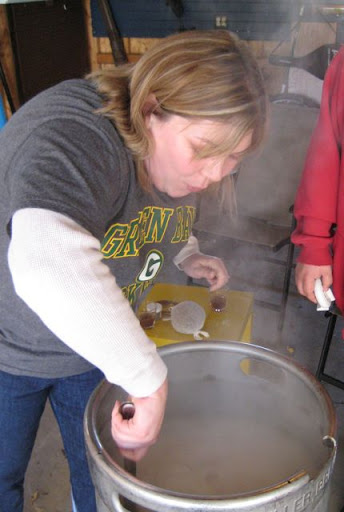
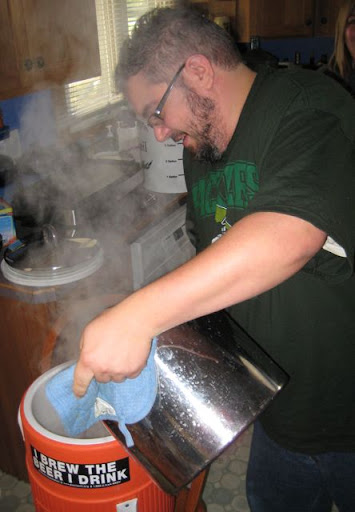 Ask any homebrewer and they’ll tell you, the most difficult part of the whole process is the waiting. That month or two gap between brew day and the moment you finally get to drink a glass of your finished beer can seem interminable. So imagine what it must be like to brew a beer such as the one Nick and Michelle Wilinski have set out to make. “This beer is going to take us four years before it’s completely finished,” Nick says. Yes, a four-year beer. There aren’t a lot of brewers around with that kind of patience. “I think it’s one of the things we do well,” Michelle says. “We can let things sit.”
Ask any homebrewer and they’ll tell you, the most difficult part of the whole process is the waiting. That month or two gap between brew day and the moment you finally get to drink a glass of your finished beer can seem interminable. So imagine what it must be like to brew a beer such as the one Nick and Michelle Wilinski have set out to make. “This beer is going to take us four years before it’s completely finished,” Nick says. Yes, a four-year beer. There aren’t a lot of brewers around with that kind of patience. “I think it’s one of the things we do well,” Michelle says. “We can let things sit.”Nick and Michelle are members of the Society of Oshkosh Brewers and they are in the process of making a Gueuze, a beer derived from the blending of straight Lambics of various ages. They’re into the second year of the project and at the beginning of October brewed their middle Lambic, which will age two years before it is blended with two other Lambics - one a year older; the other a year younger. The final blended beer will then age a year before it will be ready to drink. Their schedule for the beer has them brewing or blending around the time of their wedding anniversary each year, making it easy to keep track of where they are in the process. “We like to do that with a lot of things we brew,” Michelle says. “We’ll brew things specifically for a holiday or special day. It really makes you look forward to it.”
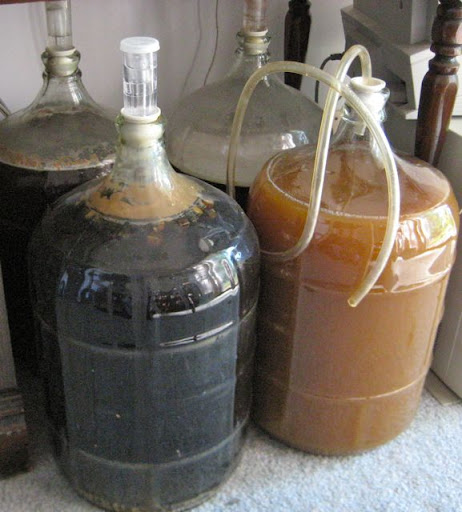
Committing yourself to a four-year beer may seem a bit much for most brewers, but Nick says it’s less complex than it first appears. “What’s so extreme about a Lambic?” he says as he goes through the process and ingredients they’re using to make these beers. The grain bill is simple - 60% Pale Malt and 40% Wheat Malt mashed at 150º for 90 minutes. It all seems quite familiar until you get 30 minutes into the 90 minute boil. That’s when the hops come in. These aren't the sort of hops you’re used to, though. The four ounces Nick tosses into the kettle are brown, brittle things that look like they’ve been sitting around in a paper bag for a good, long while. They don’t smell like much, either. Kind of musty, if anything at all. But they’re just what’s needed for this beer. The hops were grown in Oshkosh and purposely aged to remove their flavoring qualities. “The hops are used only to help preserve the beer,” Nick says. “You don’t want any of their flavor or aroma in this style.” From there the brew day proceeds like any other. The wort is cooled and drained into a carboy, the yeast (Wyeast 3278) is pitched and the beer goes to its resting place where it will be left undisturbed to ferment and develop for the next two years. “In a few years we’re going to have a glut of beer on hand!” Michelle says.
“People think of these beers as exotic, but actually they’re simple to brew,” Nick says. “This is a single-vessel beer. We won’t do anything with it for another two years.” That’s when the blending will begin. “That will be the hard part,” Nick says. Blending three, flat beers - each with varying degrees of acidic, sour and earthy flavors - into a final batch that will develop into something quite different from its distinct parts is a skill that can take years to acquire. Three years from now, Nick and Michelle will take their own, self-taught, one-day crash course in blending and hope for the best. "That's going to be interesting,” Nick says. “That’ll be fun." And though Nick and Michelle are obviously having a good time on their way to creating this beer, there’s also a practical aspect to the endeavor. “We like a lot of obscure beers that are hard to find,” Michelle says. “If you can make them yourself, it means you can have them more often.” Nick chimes in, “That’s what it is! A lot of the beers we like, you have to drive an hour to get. If we brew these beers at home we can always have them around and it’s considerably cheaper than buying a $20 bottle of Cantillon.”
So what if the beers they loved were easier to get and not so expensive. Would they stop going to the trouble of brewing them at home? They both laugh at the idea. “No, way!” Nick says. “We’d still make our own.”
Monday, October 11, 2010
Freedom To Brew
 |
| ODN August 31, 1928 |
The reality, of course, is that - legal or not - people in Wisconsin had been brewing their own beer all along. In fact homebrewing’s greatest surge in popularity probably occurred during the dry years of Prohibition (1919-1933) when the surest way to secure your stock of beer was to make it yourself. Oshkosh, in particular, was a hot-bed of homebrewing during the 1920s and though the manufacture of any quantity of beer was strictly illegal the practice of homebrewing was so commonplace here that the act of making beer was taken for granted. Malt extract and hops were sold in most Oshkosh drug and grocery stores during Prohibition and the Oshkosh Daily Northwestern was dotted with advertisements for homebrew instructions and supplies. The paper even ran a number of features during this period that casually addressed the popularity of homebrewing and wasn’t above offering homebrew tips - “CHLORINATION OF WATER NOT GOOD FOR HOME BREW” warned a headline from the Oshkosh Daily Northwestern of March 19, 1932.
To get a sense of the agreeable approach that many in Oshkosh held towards the illegal practice of homebrewing, here’s an article that appeared in the Oshkosh Daily Northwestern almost 80 years ago, on November 25, 1930. The overall tone is somewhat sexist and short-sighted, but if you’ve ever brewed your own beer you’ll probably recognize a bit of yourself in the author’s words. The roots of homebrewing in Oshkosh run a lot deeper than 1978.
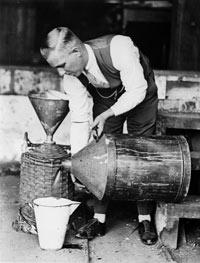 Brewing A Home Art
Brewing A Home ArtPassing of the household arts is sometimes deplored. Pies, perhaps not of the kind that grandmother used to bake, come from the delicatessen shop around the corner. "Mother's bread" is the product of the bakery. Pickling and preserving has gone to concerns famous for 57 varieties, or numbers approaching that figure. But one of the ancient household arts is being revived. Fred Pabst, president of the Pabst corporation., which once played a part in the production of the beverage that made Milwaukee famous, estimates that the consumption of home brewed beer in the United States increased last year 18 percent. The estimate is based upon sales of malt syrups. More than that, home brewing continues to spread. The increase of 18 percent in a year compares with an increase of 34 percent in October, 1930, as compared with October, 1929. Here is a household art that tends to keep the men at home. The brewing of the family beer is a task that appeals to the man of the family. He is no longer a stranger to the kitchen, or the kitchenette, as the case may be. He may never have learned to cook steak or an omelet, but his technique in apportioning the syrup and the water approaches perfection, and he is versed in the temperatures to be maintained while the brew is "working." There are stern moralists who will deplore this spread of a household art. It may be made the subject of sermons on the tendencies of the times. There will be expressions of sorrow at the transformation of the land of the free into the land of freedom to brew. Others will see in this condition an argument for the legalizing of the sale of beer. If there is to be universal brewing why not let the brewery supplement the bakery? Then this latest of the household arts may again fall into a state of innocuous desuetude, save for the few. As there are housewives who bake bread in an era of bakeries, so there might be householders who brewed beer with breweries once more in operation. We might come to the time when the old-fashioned man would be described as one who brewed his own.
Thursday, October 7, 2010
Oshkosh Beer of the Week: Hinterland Luna Coffee Stout
All right, I admit it, the only reason I bought this stuff was that I liked the fancy, 16-ounce bottles. I figured I’d swallow a four-pack and then recycle those sweet jugs to dress-up a few pints of my homebrew. Turns out, it ain't just the bottle that’s pretty. This beer is a beauty and perfect for fall guzzling. Luna is an easy drinker that starts with a percolating coffee aroma and flavor that glides gently into all manner of dark-malt subtlety as it permeates your innards. Along the way you get a little bit of burnt pizza crust, some peat, a hint of chocolate... it’s a well-rounded, flavorful beer that doesn’t punch you in the throat to get its point across. If you’re the sort that likes to fuss about style guidelines, this one hits all the requisite marks for an American Stout. The mouthfeel has a pleasant heft with just enough roasty bitterness to cut the wash of creamy sweetness that underlies the whole set-up. That dark-malt aspect grows slightly astringent towards the very end, but not at all in a bad way. A top-notch stout from top to bottom and one I’ll be revisiting... not just for the bottles, either.
You can find Luna Coffee Stout at Festival Foods in Oshkosh. It snuck into town a little over a week ago in that pile of Hinterland they've got stacked at the entrance to the liquor department. You'll probably have to dig some to find the Luna, but rest assured, there's plenty more in there. And if you want to learn about what's going on up at the Hinterland Brewery in Green Bay, here's an interesting interview with Hinterland brewmaster Joe Karls. It's the classic homebrewer to pro-brewer story and it'll have you liking the beer even more.
You can find Luna Coffee Stout at Festival Foods in Oshkosh. It snuck into town a little over a week ago in that pile of Hinterland they've got stacked at the entrance to the liquor department. You'll probably have to dig some to find the Luna, but rest assured, there's plenty more in there. And if you want to learn about what's going on up at the Hinterland Brewery in Green Bay, here's an interesting interview with Hinterland brewmaster Joe Karls. It's the classic homebrewer to pro-brewer story and it'll have you liking the beer even more.
Tuesday, October 5, 2010
It'll Be Pouring Potosi at Barley & Hops
You probably already know how this works: About once a month, Nate at Barley & Hops hosts a beer tasting where he invites a brewery to come in and pour their wares. And this month the brewery in the spotlight will be good, old Potosi! Another great choice by the Barley’s crew. If you’ve yet to familiarize yourself with the ales of Potosi, now is your chance to belly-up and take the crash course in Potosi appreciation. They’re making some fine beer out there in the hills of Southwestern Wisconsin and for just $10 you’ll be treated to the grand tour of their recreational liquids.
The Potosi kick-off party begins tomorrow (Wednesday) evening at 7 and will go until 10. In addition to all that fine beer, they’ll also be pouring samples of Barefoot Wines and Captain Morgan Lime Bite Rum along with a varied assortment of other beers and boozes. At $10 this is a steal and sure to make your Wednesday night a memorable one... even if Thursday finds you unable to remember it. Check out the Barley’s Facebook page for more info.
The Potosi kick-off party begins tomorrow (Wednesday) evening at 7 and will go until 10. In addition to all that fine beer, they’ll also be pouring samples of Barefoot Wines and Captain Morgan Lime Bite Rum along with a varied assortment of other beers and boozes. At $10 this is a steal and sure to make your Wednesday night a memorable one... even if Thursday finds you unable to remember it. Check out the Barley’s Facebook page for more info.
Monday, October 4, 2010
Oshkosh Greets Theodore Mack
Forty years ago this week Oshkosh began coming to terms with the fact that it was now home to America’s first black-owned brewery. On October 3, 1970 Peoples Brewing Company announced it would hold a ribbon-cutting ceremony and open house to celebrate the arrival of its new President, Theodore F. Mack Sr., who had been tersely introduced six months earlier by the Oshkosh Northwestern as “a Milwaukee negro”. The ensuing months were marred by acrimony and rumors, some of them recirculated by the Northwestern, that Mack would change the company’s name and hire only black workers. The announcement of the open house set the stage for an odd bit of theater designed to show that Mack was a businessman who could be trusted and that Oshkosh wasn’t composed entirely of bigots.
The event took place on Saturday October 10, 1970 and began with a ribbon cutting ceremony that was as symbolic as it was ironic considering that the brewery was now 59 years old and nearly insolvent. Mack cut the ribbon and told the crowd “In these days of confrontation, you make a pretty picture standing there, black, white and brown.” Standing before a crowd of approximately 2,000 people, Mack was praised by guest speakers for his “courage, initiative and guts” and was officially welcomed to Oshkosh by Council President Byron Murken. Mack thanked Murken saying, he “took the heat along with me” during the previous six months. With that, the crowd was welcomed into the brewery for a tour, a lunch of hot dogs and potato chips and a few glasses of “tap-fresh” Peoples beer. Estimates put the total number of people who toured the brewery that day at 5,000. Brewery presidents had been coming and going in Oshkosh for more than 100 years. None of them had gotten the sort of reception that greeted Mack.
Taken at face value, the event looks like an awkward mea culpa staged to gloss over the eruption of bigotry that followed the news that Mack was trying to purchase the brewery. But if you dig a little deeper you find that perhaps the show of support Mack received in October of 1970 was more earnest than it appears. Before Mack was able to complete his purchase of the brewery, he needed to raise an additional $200,000 to supplement the $390,000 loan he had already acquired. Mack’s plan for raising the additional money was to sell stock in the company. Within five weeks of the stock going on sale he had the money he needed and, according to Mack, much of that stock had been purchased by Oshkosh residents. The Sunday following the event the Milwaukee Journal quoted a “white woman doctor” who didn’t wish to be named who said, “Investing in Peoples Brewery is not like watching the stock market. It’s watching a venture in which we are all concerned.” That’s quite a contrast to the attitudes reported upon six months earlier when, amidst the uproar, nobody bothered to notice that there were a significant number of people in Oshkosh capable of identifying with and investing in the dreams of a black man.
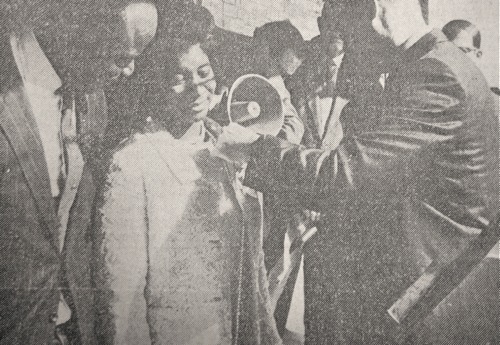 |
| Theodore and Pearlie Mack October 10, 1970 |
Taken at face value, the event looks like an awkward mea culpa staged to gloss over the eruption of bigotry that followed the news that Mack was trying to purchase the brewery. But if you dig a little deeper you find that perhaps the show of support Mack received in October of 1970 was more earnest than it appears. Before Mack was able to complete his purchase of the brewery, he needed to raise an additional $200,000 to supplement the $390,000 loan he had already acquired. Mack’s plan for raising the additional money was to sell stock in the company. Within five weeks of the stock going on sale he had the money he needed and, according to Mack, much of that stock had been purchased by Oshkosh residents. The Sunday following the event the Milwaukee Journal quoted a “white woman doctor” who didn’t wish to be named who said, “Investing in Peoples Brewery is not like watching the stock market. It’s watching a venture in which we are all concerned.” That’s quite a contrast to the attitudes reported upon six months earlier when, amidst the uproar, nobody bothered to notice that there were a significant number of people in Oshkosh capable of identifying with and investing in the dreams of a black man.
Subscribe to:
Comments (Atom)












